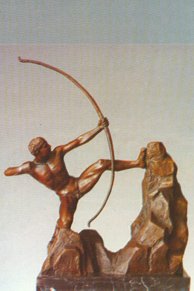Shastralakshana, Śastralakṣaṇa, Shastra-lakshana: 3 definitions
Introduction:
Shastralakshana means something in Hinduism, Sanskrit. If you want to know the exact meaning, history, etymology or English translation of this term then check out the descriptions on this page. Add your comment or reference to a book if you want to contribute to this summary article.
The Sanskrit term Śastralakṣaṇa can be transliterated into English as Sastralaksana or Shastralakshana, using the IAST transliteration scheme (?).
In Hinduism
Dhanurveda (science of warfare)
Source: archive.org: Catalogue of Pancaratra Agama Texts (dh)Śastralakṣaṇa (शस्त्रलक्षण) (lit. “a description of the Lord’s weapons”) is the name of chapter 10 of the Ṛṣirātra section of the Sanatkumārasaṃhitā: an encyclopedic Sanskrit text written in over 3500 verses dealing with a variety of topics such as yoga, temple-building, consecration ceremonies, initiation and dhanurveda (martial arts).
Description of the chapter [śastralakṣaṇa]: Sanatkumāra offers to recount the story of how the weapons of the Lord came into being when the gods requested Nārāyaṇa to help them in their encounters with the demons. At their request He produced the cakra-discus from His mouth, the khaḍga-sword from His right foot, the musala-pestle from His left foot, and also the śārṅga-bow, the gadā-mace, the triśūla-trident, the paraśu-axe, the śakti-spiked-missile, the pāśa-noose, the tomara, the vanamālā-garland, the aṅkuśa-goad, the kṣurikā-razor, etc. These the Lord gave to different deities—for examples, the pāśa-noose went to Varuṇa, the triśūla-trident to Śiva, the paraśu-axe to Brahmā, etc. (1-31). He also composed a handbook, known as the Dhanurveda, which has been passed down from generation to generation. It tells how to use these weapons, both as astra or as śastra effectively. Of all the weapons, the best is the dhanus-bow—and there are several five-fold classifications of weapons given here, along with the five types of people who may most effectively use them, the five grips most sure to give careful aim, etc. (32-55).
Since Viṣṇu presides over the powers inherent in all the weapons, one who would become an expert “sharp-shooter” [astraśikṣā] should undertake dīkṣā-initiation using the cakramaṇḍala in which Viṣṇu with His astra and śastra-weapons is honored (56-64).

Dhanurveda (धनुर्वेद) refers to the “knowledge of warfare” and, as an upaveda, is associated with the Ṛgveda. It contains instructions on warfare, archery and ancient Indian martial arts, dating back to the 2nd-3rd millennium BCE.
Languages of India and abroad
Sanskrit dictionary
Source: Cologne Digital Sanskrit Dictionaries: Aufrecht Catalogus CatalogorumŚastralakṣaṇa (शस्त्रलक्षण) as mentioned in Aufrecht’s Catalogus Catalogorum:—on weapons. Bik. 708.
Source: Cologne Digital Sanskrit Dictionaries: Monier-Williams Sanskrit-English DictionaryŚastralakṣaṇa (शस्त्रलक्षण):—[=śastra-lakṣaṇa] [from śastra > śas] n. Name of [work] -2.
Sanskrit, also spelled संस्कृतम् (saṃskṛtam), is an ancient language of India commonly seen as the grandmother of the Indo-European language family (even English!). Closely allied with Prakrit and Pali, Sanskrit is more exhaustive in both grammar and terms and has the most extensive collection of literature in the world, greatly surpassing its sister-languages Greek and Latin.
See also (Relevant definitions)
Partial matches: Lakshana, Shastra.
Query error!
Full-text: Shastra, Astra, Tomara, Sharnga, Kshurika, Dhanus, Dhanurveda, Cakra, Pasha, Ankusha, Gada, Parashu, Trishula, Khadga, Vanamala, Shakti, Musala.
Relevant text
Search found 3 books and stories containing Shastralakshana, Śastra-lakṣaṇa, Sastra-laksana, Śastralakṣaṇa, Sastralaksana, Shastra-lakshana; (plurals include: Shastralakshanas, lakṣaṇas, laksanas, Śastralakṣaṇas, Sastralaksanas, lakshanas). You can also click to the full overview containing English textual excerpts. Below are direct links for the most relevant articles:
Notices of Sanskrit Manuscripts (by Rajendralala Mitra)
Nighantu (critical study) (by Gopalakrishna N. Bhat)
Part 11 - Vannamani (Vac Nama) < [Chapter 3 - First Adhyaya (chapter) of the Nighantu (study)]
AYU (Journal of Research in Ayurveda)
Significance of Shringagrahika Nyaya (maxim) in understanding Charaka Samhita in context to commentary of Chakrapani < [Volume 39 (3); 2018 (Jul-Sep)]